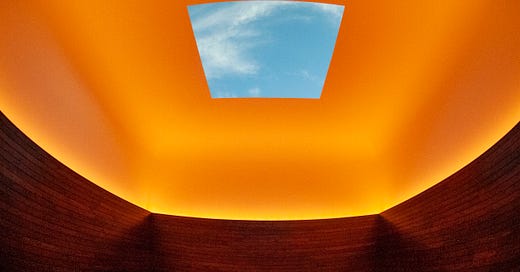By Josh Miller. Watch him narrate the piece here.
I cried the first time I saw the sun set in a James Turrell Skyspace.
Believe it or not, this is a normal reaction. Most people tear up at least a little bit when they literally come face to face with the age-old question…
Why is the sky blue?
I sat, as you do, in a small stone room with a large, square cutout in the ceiling… surrounded on all sides by colored light. Through this cutout you can see the sky, but this sky isn’t exactly as it seems.
The 40 minute “exhibit” lasts from dusk until dark. As the sun begins to go down, the color of the sky changes along with the lights in the room — slowly but vibrantly.
Dictated by the changing light on the ceiling, it was like the sky lost all agency, turning every color imaginable. Colors I never thought possible!
“This thing I’m looking at… is it still the sky?” I asked myself more than once.
It wasn’t long before other perceptions were called into question. Depth, time, space. The little stone room, it inverted them all.
And I guess that’s the whole point — what Turrell was trying to say without having to say it. How easily our perceptions and preconceived notions of what is and what isn’t can be called into question…
…by something as simple as the act of manipulating light.
This week, we introduced what we like to think of as a similar ability. But instead of manipulating light, you’re manipulating the fabric of the internet itself.
Its color, texture, typography, and even what parts appear (or disappear) completely.
To change the way the internet looks changes your relationship to everything in it, and reveals the truth — or mystery — behind every site you visit.
And if you change the internet to better reflect you — your personality, preferences, and aesthetic — something even more magical happens.
Our traditional relationship with the web, as viewers, is inverted. For many of us, for the first time, we become the creator.
Why do this?
Not because it’s particularly useful. A purple Twitter written in Comic Sans is not a more practical Twitter, necessarily. But it is yours.
It allows you to frame the digital world using the same light Turrell did. To wrestle back power from the seemingly irrevocable nature of the sky, or of the services we inhabit each day online.
To make a statement. Not political, or even artistic. Just personal, and deeply felt.
We think our world only works in a certain way. But maybe it doesn’t?
What is a phone? What is a president? What is fashion? What is a webpage?
And then something comes along that challenges our perception of what is possible.
What is a phone? What is a president? What is fashion? What is a webpage?
What is a webpage?
When we change our perception of what is possible, we change the future by introducing something that wasn’t there before. Like an internet that can and should be molded by you, not by corporations.
Our digital rectangles — where we spend hours and hours every single day, week over week. Shouldn’t we have a say about how they feel to us?
Now, we do.
But more than anything, I hope this serves as a reminder that it’s all just made up.
All of it. And a reminder that it can be made and remade over and over again. Always.
That “different” is always possible. That better is always possible.
A reminder of what could be.
And finally… that your internet, your way, is right there for the taking…
All by the simple act of manipulating light.











Given that Arc Boosts can impact the access to buttons and other functions of a website are there any plans to offer data back to the sites so they can learn from actual user behaviors?
Insights that could be interesting to Product Mangers of the sites would include content being hidden by users, how many users actually utilize a boost, and other data that helps them improve the website for everyone.
Beautifully conceived and written! Evokes such emotion!